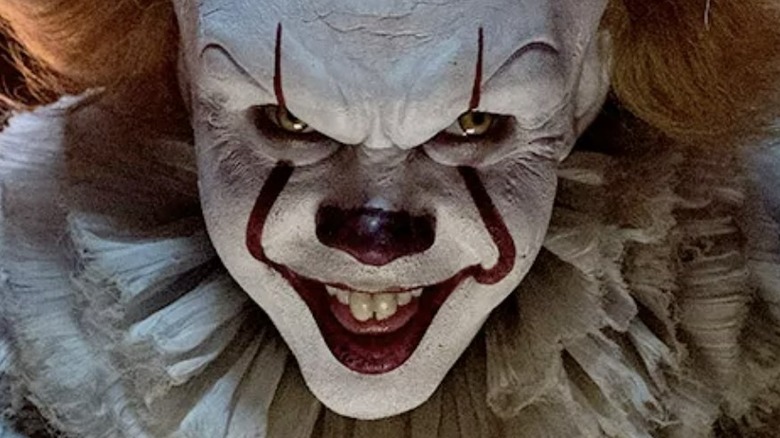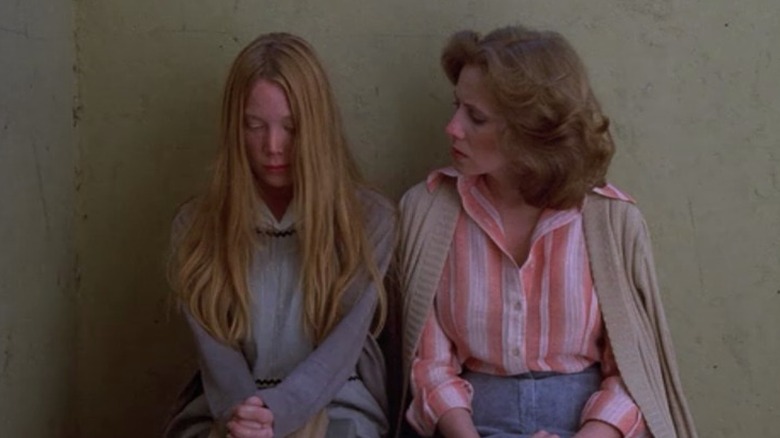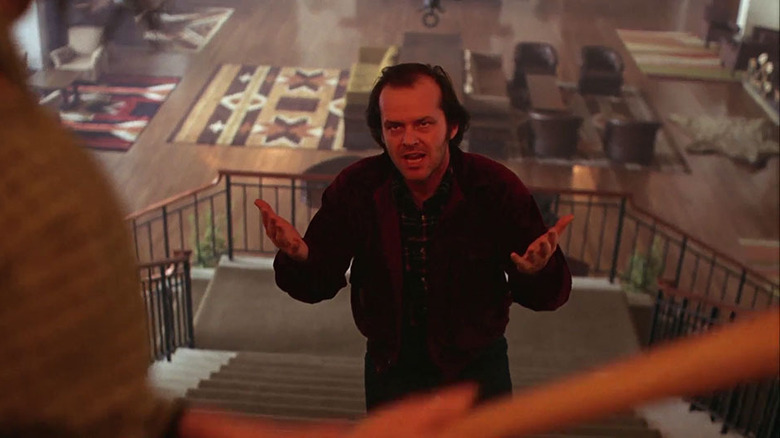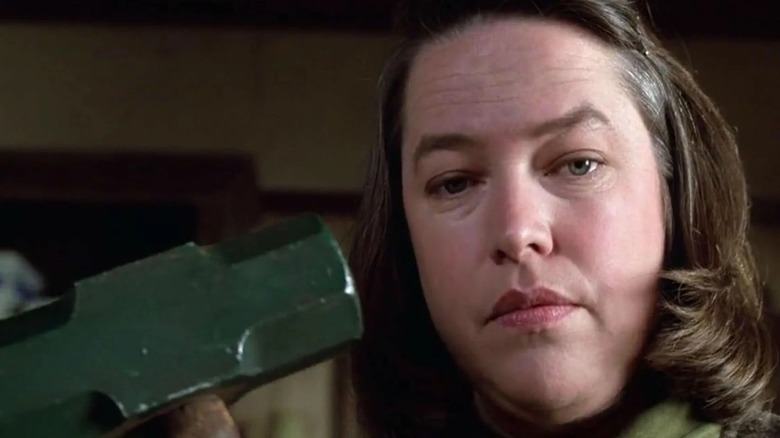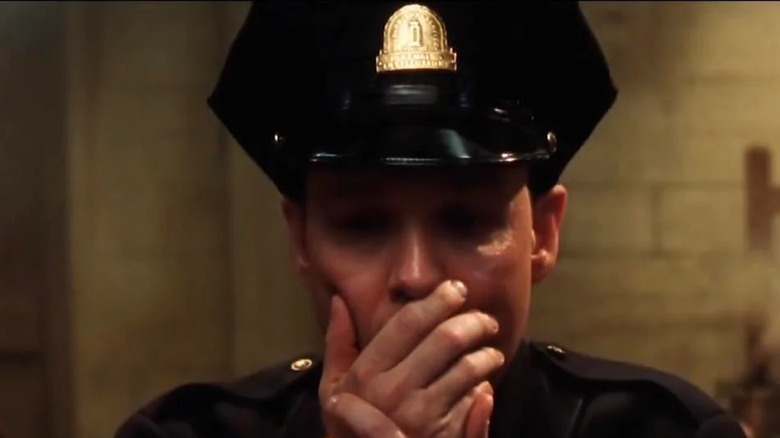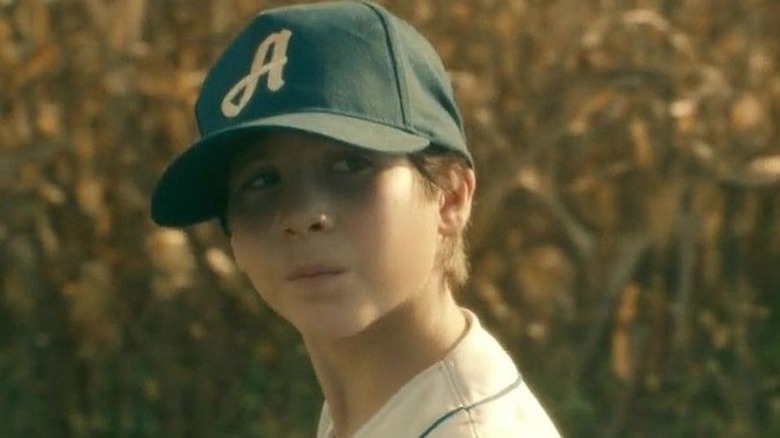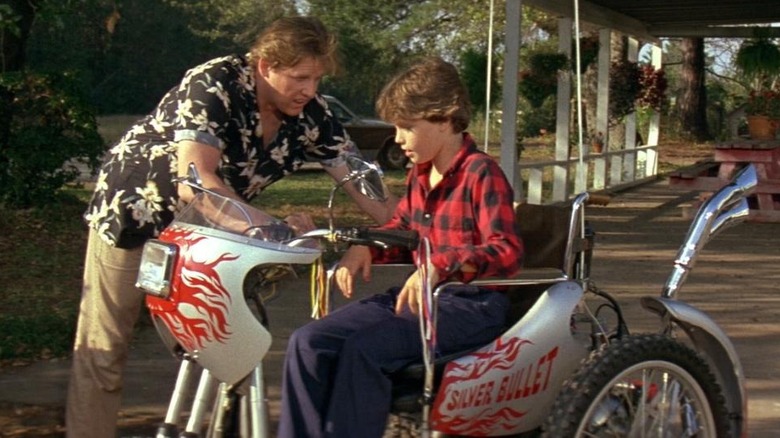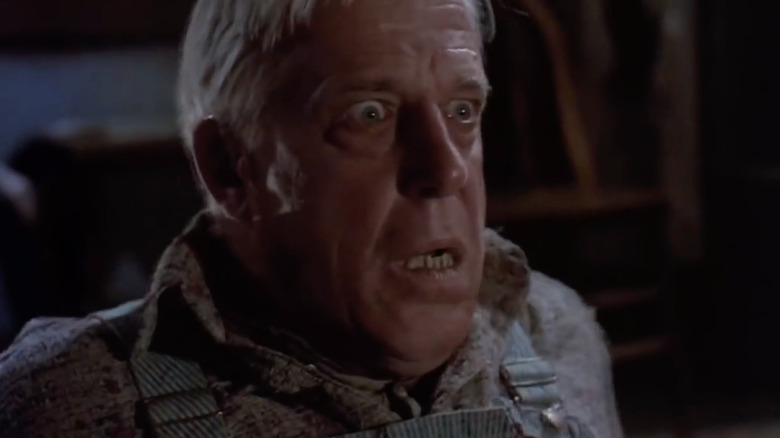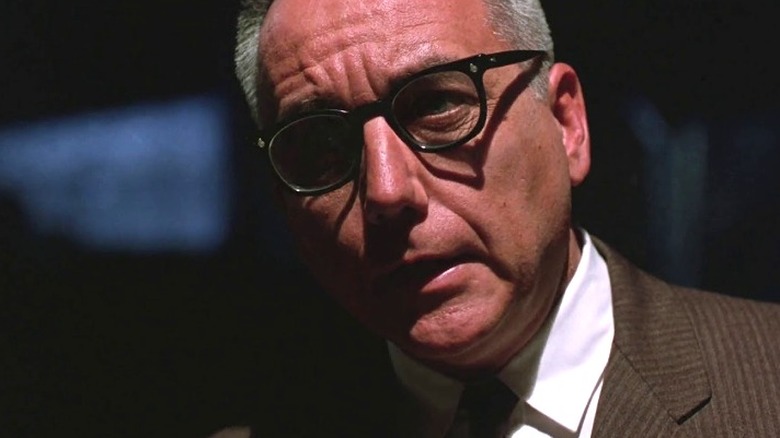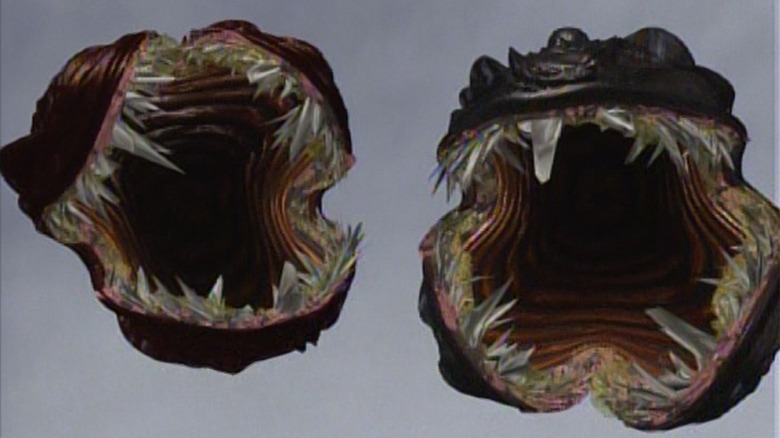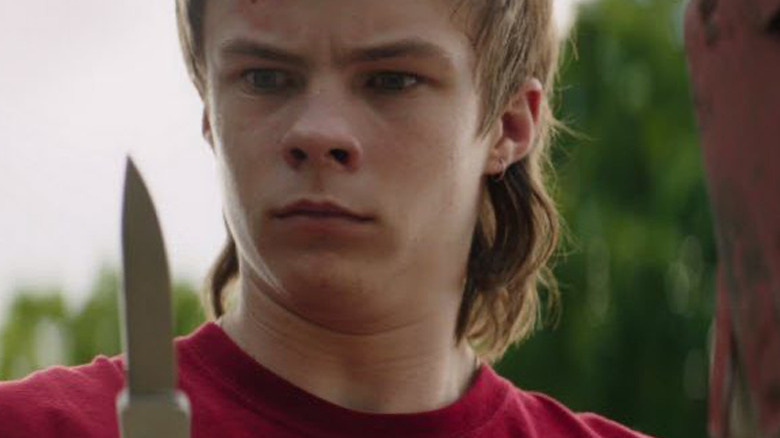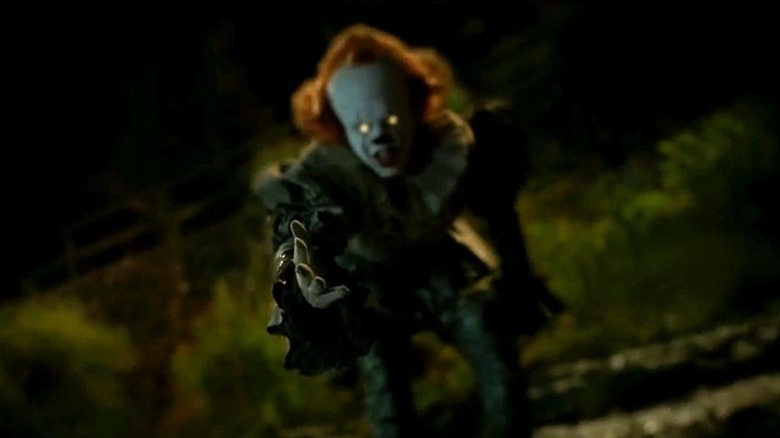Moments In Stephen King Adaptations That Went Too Far
Very few writers, horror or otherwise, have achieved the widespread success and mainstream notoriety that Stephen King has. Even if you've never gleaned a word of the man's creations, you've more than likely known them through pop cultural osmosis. From "The Shining" to "It" to "Carrie" to "Dolores Claiborne," his stories have ranged from the disturbingly grounded to the graphically fantastical. His tales have always benefited from their mix of casual dialogue, masterful suspense and disturbing prose. With over 350 million copies sold and countless adaptations of his books, one cannot deny his immense legacy.
That being said, much like any prolific creator, King has often crossed a few lines in terms of his work. Be it his own writing or the decisions made regarding the countless cinematic adaptations of it — there have been many moments that were of questionable taste. Whether it be an overly violent moment or something utterly embarrassing, there are moments in Stephen King adaptations that went too far.
The shower scene from Carrie
"Carrie" is noteworthy for many reasons, not the least of which is that it's the first major adaptation of Stephen King's writing. It also has two of the best performances ever featured in a King adaptation, courtesy of Sissy Spacek and Piper Laurie, both of whom were nominated for Oscars. What makes the film such a memorable watch is just how much sympathy you end up feeling for Carrie (Spacek). Not only does she receive abuse from her religious fanatic of a mother (Laurie), but she's also victimized by the girls at school. This is immediately shown to us — in as cruel and embarrassing a fashion as possible — in the film's opening sequence.
We see Carrie having a shower after gym when unfortunately she has her very first period, much to her embarrassment since her mother has never informed her about it. This leads to her fellow classmates taunting her, laughing at her and even throwing tampons at her. Despite the supernatural horror the film is known for, this might honestly be the hardest scene to watch. It's quite cruel and might hit a bit too close to home for anyone who was bullied back in high school.
The staircase scene from The Shining
When it comes to adaptations of Stephen King's work, "The Shining" definitely strays far from its source material. Ever since the film's 1980 release, it's been a frequent talking point regarding the various ways that the film differs from the book. However one aspect of the Stanley Kubrick-helmed adaptation that was perfectly replicated was Jack Torrance's gradual descent into madness. This is due in no small part to not only Kubrick's impeccable direction, but the performance of the legendary Jack Nicholson. Nicholson's masterful command of legitimate menace and morbid humor is best showcased when Wendy (Shelley Duvall), Jack's wife, discovers his manuscript.
What she finds are reams after reams of paper plastered with the words "All work and no play make Jack a dull boy." This leads to a tense sequence where Wendy, armed with a bat, attempts to defend herself as Jack threatens her with violence. It's a great scene with a rather unpleasant backstory, as it's been revealed that Duvall's tearful state was unfortunately all too real. Ever the perfectionist, Kubrick forced Duvall to do the scene a grand total of 127 times (via The Hollywood Reporter) until he was satisfied. While the scene itself did turn out excellent, one cannot deny that Kubrick likely went way too far.
The ending of The Mist
Based on the eponymous novella, "The Mist" was directed by Frank Darabont — best known for helming the first season of "The Walking Dead." Much like the long-running zombie series, Darabont's adaptation of King's story focuses on human conflict amidst otherworldly circumstances. The scenario here takes place in a small town that ends up covered in a mysterious mist, which hides a legion of hungry Lovecraftian horrors. While the monsters tear the town apart, the citizens stuck in the supermarket grow closer and closer to tearing each other apart as well.
Near the end of the film, David (Thomas Jane), his son Billy, and a few other survivors flee the supermarket and attempt to drive through the mist. This unfortunately leads to them running out of gas, causing the group to make a tough and tragic call. In order to spare them from death at the hands of the monsters, David kills them all with his remaining gun. This, however, is shown to be all for nothing, as mere moments later the mist dissipates and the National Guard arrives. In terms of downer endings, there likely are fewer more gutting and infuriating than the closing moments of "The Mist."
The hobbling scene from Misery
When your film's success is contingent on only two major characters, you'd better be sure the roles are in safe hands. Luckily in the case of "Misery," the film benefits from two truly magnificent performances courtesy of James Caan and Kathy Bates, who won an Oscar for Best Actress for her work.
Caan plays Paul Sheldon, writer of the wildly popular "Misery" book series who has just completed its final installment. After an unfortunate car accident, a bruised and battered Paul finds himself in the care of Annie Wilkes (Kathy Bates). Annie, a former nurse and Paul's self-professed number one fan, immediately begins tending to Paul and his broken legs. But things take a turn when Annie, none too pleased about Paul killing off Misery in the latest book, forces him to write a new one.
Annie's abuse of Paul becomes increasingly worse throughout the film, turning from harsh verbal comments to legitimate physical violence. The latter culminates in quite possibly one of horror cinema's most sickening sequences, with Annie looking to re-break Paul's legs. She achieves this by putting a block of wood between Paul's ankles and hobbling him with a sledgehammer. It's an utterly horrific sequence, unmatched by anything else in the film in terms of disturbing imagery.
The sponge scene from The Green Mile
Oftentimes the more realistic onscreen violence is, the more disturbing and resonant it becomes for the audience. "The Green Mile" is one of the very few Stephen King stories that doesn't have a monster or a legitimate otherworldly threat. While the story is predicated upon a supernatural element, the events shown are played fairly straight and realistically. The story follows a death row prison guard named Paul (Tom Hanks) who, during his employment at Cold Mountain Penitentiary, witnesses a series of strange events. These events seem to be the result of a new inmate, John Coffey (Michael Clarke Duncan), who has some form of healing touch.
Partway through the film, one of the other prisoners, Del (Michael Jeter), is set to be executed via the electric chair. This process would normally be a quick and relatively painless affair, but due to the machinations of a sadistic guard named Percy (Doug Hutchison), it doesn't go that way. Percy decides not to soak the sponge used for the execution in water, which prolongs Del's death throes. It's a viscerally unpleasant experience, made all the more disturbing when you learn the reality behind electric chair executions.
The baseball kid's death in Doctor Sleep
While an unfortunate box office disappointment, "Doctor Sleep" did receive a fair amount of praise from critics and audiences. The film follows a grown-up Danny Torrance, still dealing with trauma due to his stay at the Overlook Hotel. Despite this, Danny has managed to keep the ghosts of his past at bay and even sought counseling for his substance abuse. However, a threat known as the True Knot — a gang of vampire-like immortals –- rear their heads. The True Knot feast off of anyone who, much like Danny, has a special gift or power.
In an especially disturbing sequence, we see them lure a young Little League player into their van and drive off. They take him to a construction site where they proceed to not only stab him, but consume his essence as well. What makes the sequence even worse is you get to see almost every moment of this poor child screaming in agony. Child death is far from uncharted territory for King adaptations –- just watch "Pet Sematary" –- but this one definitely pushes the limits.
The motorcycle wheelchair from Silver Bullet
"Silver Bullet" is definitely one of the cheesier Stephen King adaptations, but that is in no way a bad thing. The film follows Jane Coslaw and her younger brother Marty dealing with a series of gruesome murders in their small hometown. These murders turn out to be the work of Reverand Lowe, who turns into a werewolf when the moon is full. We also meet the siblings' lovable but alcoholic Uncle Red, played by the incomparable Gary Busey. Partway through the film, Red bestows upon Marty a very special gift — a motorcycle wheelchair. Bear in mind that this is a film with a bloodthirsty werewolf, yet somehow this wheelchair is far more inexplicable. What makes it even stranger is just how straight the film plays it, never once bringing up how ridiculous it is.
Not only does Marty use it often, but he even uses it to escape the werewolf while it's in human form as Reverend Lowe. The film is a campy and enjoyable werewolf flick, but a motorcycle wheelchair might have been just a step too far in believability.
Gage killing Jud from Pet Sematary
A recurring motif among many of King's novels is creepy children, often imbued with a healthy dose of the supernatural. From "Carrie" to "The Shining" to, most relevant here, "Pet Sematary," if a child appears in a King adaptation there's a strong bet they'll be spooky. Like the book, the film follows the Creed family: Louis, his wife Rachel and their two kids, Gage and Ellie. The family is eventually shown the local pet cemetery by their older neighbor Jud, played by the former Herman Munster, Fred Gwynne. Eventually Louis learns more about the cemetery –- how burying something there leads to its resurrection, but how they come back wrong.
This coincides with not only the death of the family's cat, but eventually their own son Gage, who is hit by a truck. Against the warning of Jud (and a ghost named Pascow), Louis opts to bury Gage in the cemetery to bring him back. Gage does indeed reanimate, but returns completely evil and bloodthirsty — and proceeds to murder poor Jud with a scalpel. The sequence is uncomfortably brutal and gory, and will make even the most hardcore horror fan squirm.
Tommy's death in The Shawshank Redemption
In terms of emotional resonance, very few Stephen King stories hit the way that "The Shawshank Redemption" does. Lacking any form of the supernatural, the story nevertheless stands out among the rest of King's prolific output. The story follows Andy Dufresne (Tim Robbins), a former banker who's now an inmate after the alleged killing of his cheating wife and her lover. Over the course of his multi-year stint at Shawshank prison, he makes friends with a con man named Red (Morgan Freeman). Partway through the film we're introduced to Tommy (Gil Bellows), a new inmate who ingratiates himself rather quickly with Andy and Red.
Tommy reveals that while doing a stint at another prison, he heard another inmate admit to the crimes Andy took the fall for. Andy sees this as his ticket to freedom, but the stringent warden Samuel Norton (Bob Gunton) quickly puts an end to it. Not only does he begin making life hell for Andy, but in order to keep this information secret, he has Tommy shot. It's a gut-wrenching moment to witness, and serves as the major catalyst for Andy finally escaping from the prison.
The CGI in The Langoliers
It's not uncommon for Stephen King stories to go big or go home when it comes to their respective climaxes. Sometimes this results in something excellent, like the prom sequence from "Carrie," or in the case of "The Langoliers," something insanely stupid. The 1995 television adaptation follows a group of passengers who, while on a flight to Boston, awaken to discover the other passengers gone. They land and eventually discover that it's not only their flight that is deserted, but the entire airport as well. Along for the ride is Craig Toomy (Bronson Pinchot), an anxiety-ridden business man with a fear of the titular Langoliers. It's explained that the Langoliers are monsters his father told him about during his childhood that eat the irresponsible and lazy.
Eventually, the group discovers that during their flight they entered an aurora borealis which has detached them from the timeline. However it appears that the past has a cleanup crew, which is none other than the Langoliers. What ensues are several minutes featuring some truly horrendous computer graphics, on par with early Nintendo 64 games. Any intrigue or sense of ambiguity is lost, most likely replaced by viewers with groans and unintentional laughs.
Henry killing his father in It: Chapter One
It's amazing that in a film about an ancient entity masquerading as a murderous sewer-dwelling clown, a "normal" murder would be the most disturbing. Aside from Pennywise the Dancing Clown, the Losers Club has to contend with the abuse of local bully Henry Bowers (Nicholas Hamilton). The group encounters Bowers and his gang several times throughout the film, finally getting the better of them in a rock fight. Henry then suffers another humiliation, this time at the hands of his stern police officer father, in front of his cronies. Following this, Henry sees a red balloon affixed to his home mailbox, within which he finds his lost pocket knife. Throughout the scene's buildup, all we hear are the foreboding sounds of children laughing, which only adds to the dread.
Henry then returns inside and, motivated by Pennywise on a children's television show, stabs his father in the neck. This killing, unlike every other killing in the film, is far more brutal and displayed far more realistically. This sharp contrast to the rest of the film makes the scene fairly hard to watch, especially in terms of its violence.
The opening scene of It: Chapter Two
In terms of both critical and audience reception, "It: Chapter Two" sadly didn't fare as well as its 2017 predecessor. The film definitely leans into the more absurd developments of the book's second half, which makes for a fairly ridiculous sit. One such example of this heightened sense of camp comes in the film's opening scene at the Derry canal fair. We see a gay couple, represented through some rather outdated stereotypes, get beaten up by a group of ruthless homophobes. This results in one of the men being beaten bloody, then thrown off the bridge and into the canal. The man struggles for help until he sees a mysterious figure on land that is soon revealed to be none other than Pennywise. His partner rushes down just in time to see his boyfriend have a chunk bitten out of him by the clown.
While the scene certainly is shocking, it also indulges too much in the gay couple's brutal victimization. Including a '90s sitcom-style comeback about their attacker's hair during a vicious homophobic beating is definitely a bit tasteless.
